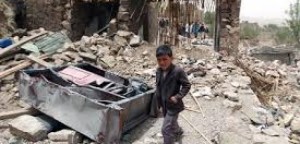Bombings kill more in Yemen as hunger, thirst spread
 Warplanes deployed by the Saudi Arabian monarchy, the Gulf Cooperation Council and their allies, all backed by U.S. imperialism, are continuing the war aimed at regime change in Yemen into the fourth month.
Warplanes deployed by the Saudi Arabian monarchy, the Gulf Cooperation Council and their allies, all backed by U.S. imperialism, are continuing the war aimed at regime change in Yemen into the fourth month.
Since March 26 when the bombing of Yemen started, some 2,600 to 4,000 people have died, according to various sources. Telecommunications infrastructure, airports, ports, residential areas, hospitals and power stations have been targeted.
On June 29 Press TV wrote, “Saudi military aircraft conducted attacks against a residential area in Sarwah district of Yemen’s central province of Ma’rib. … Nine members of a family lost their lives and three others sustained injuries. … Six civilians, among them two women and three children, were also killed as Saudi warplanes struck Shibam Kawkaban district in the western Yemeni province of al-Mahwit. … Saudi jets carried out over twenty aerial attacks against Sahar and Majz districts of Yemen’s northwestern province of Sa’ada.”
U.S.-backed forces aim to destroy
On June 28, at least three people, including a child, were also killed when Saudi war planes struck the Fallah district in the northwestern province of Sa’ada and fighter jets pounded a neighborhood in the Saqin district in the same province, destroying two schools.
The Saudi-GCC backed fugitive and ousted President Abd Rabbuh Mansur Hadi’s regime-in-exile announced in late June that there was no need to resume talks after the unsuccessful negotiations in Geneva. After delays in the talks due to obstacles placed on Ansurallah Movement (Houthis) representatives reaching Switzerland, the negotiations failed as a result of the obstructive posture of the Western-allied forces.
Hadi took the position that if he was not reinstalled as the leader of the underdeveloped Middle Eastern state, then there was no basis for the cessation of the bombing and ground offensives launched against the Ansurallah as well as civilians in the country. The Ansurallah have taken large sections of Yemen since last year, forcing Hadi to flee to the southern port city of Aden and later to Riyadh, Saudi Arabia, where he remains.
The West and its surrogates present the war as a proxy conflict between Saudi Arabia and GCC on one hand and the Islamic Republic of Iran and their allies, namely the Ansurallah in Yemen, on the other. Efforts by the United Nations to reach a political settlement, for example, by convening the June meeting in Geneva, have led nowhere.
After the talks failed, an Omani plane carrying Houthi delegates back to Saana from Geneva was denied the right to land, since the U.S.-backed Saudi-GCC bombers control the airspace. The plane returned to Muscat, Oman.
At present the U.N., while periodically condemning the airstrikes, has imposed no sanctions against the U.S. and the Saudi-GCC alliance, which is attempting to bomb Yemen into submission. Despite the war being waged for months, the Ansurallah Movement, allied with a coalition of other forces loyal to former President Ali Abdullah Saleh, has largely maintained its positions on the ground.
U.N. Secretary General Ban Ki-moon’s June 29 statement strongly objected to the imperialist-backed-coalition air strike, which severely damaged a U.N. Development Program facility and called for a return to negotiations.
Population conditions worsen
Humanitarian aid groups say that the situation is growing worse every day, with shortages of food, water, medicines and other essential services. Millions of people in Yemen need assistance.
A June 29 statement taken by the relief organization Doctors Without Borders from Jasmin Mohammed Ali, 26, a teacher in the primary school in Qatabah, and her sister Asia Mohammed Ali, 25, provides a glimpse of their daily lives in Qatabah since the Saudi-GCC bombing began.
Ali said, “Because of the ongoing crisis, the school I work in is closed; it has been closed for three months. Recently, the school (which was luckily empty at the time) was affected by the airstrikes as it is close to the central security office which was targeted; all the windows of the school were shattered.
“There isn’t any running water anymore in Qataba as the main water facility for the town and the surrounding villages stopped working due to a fuel shortage. We have no water in our house and cannot fill up the tanks either. … Airstrikes and shelling [are] making us terrified and we can’t sleep well.” (msf.org)
The U.N. special envoy for Yemen, Ismail Ould Cheikh Ahmed of Mauritania, warned on June 24 that the war-ravaged nation was one step from widespread famine, where 31 million people are in desperate need of food, water, medicines, clothing, blankets and other basic services.
The fighting is continuing to spread into Saudi Arabia where the Ansurallah and other loyalists are conducting cross-border raids that have killed and injured Riyadh’s soldiers and other security forces.
This war remains largely hidden from the U.S. public where the corporate media have deliberately ignored the massive Saudi-GCC aerial bombings and ground operations carried out by militias supported by Riyadh, as well as the role of the Pentagon in engineering the crisis. The State Department claims it wants a peaceful resolution to the war, but continues to rationalize Washington’s intelligence coordination and refueling of Saudi- GCC forces.
The assault on Yemen represents yet another failed and deadly war initiated and expanded by successive U.S. administrations whose aim is to control the Middle East at any cost to the population in those states.

